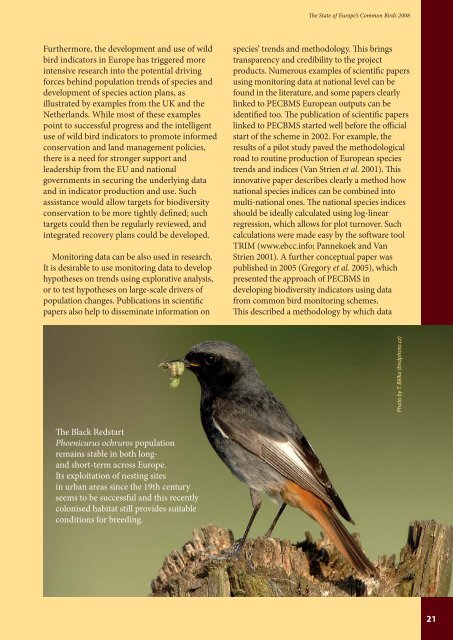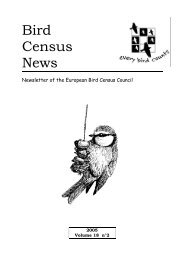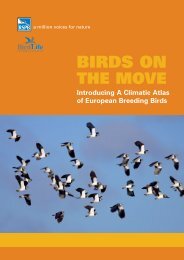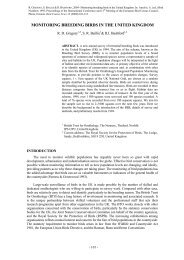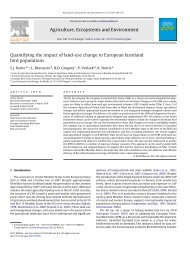The State of Europe's Common Birds 2008 - European Bird Census ...
The State of Europe's Common Birds 2008 - European Bird Census ...
The State of Europe's Common Birds 2008 - European Bird Census ...
You also want an ePaper? Increase the reach of your titles
YUMPU automatically turns print PDFs into web optimized ePapers that Google loves.
<strong>The</strong> <strong>State</strong> <strong>of</strong> Europe’s <strong>Common</strong> <strong><strong>Bird</strong>s</strong> <strong>2008</strong>Furthermore, the development and use <strong>of</strong> wildbird indicators in Europe has triggered moreintensive research into the potential drivingforces behind population trends <strong>of</strong> species anddevelopment <strong>of</strong> species action plans, asillustrated by examples from the UK and theNetherlands. While most <strong>of</strong> these examplespoint to successful progress and the intelligentuse <strong>of</strong> wild bird indicators to promote informedconservation and land management policies,there is a need for stronger support andleadership from the EU and nationalgovernments in securing the underlying dataand in indicator production and use. Suchassistance would allow targets for biodiversityconservation to be more tightly defined; suchtargets could then be regularly reviewed, andintegrated recovery plans could be developed.Monitoring data can be also used in research.It is desirable to use monitoring data to develophypotheses on trends using explorative analysis,or to test hypotheses on large-scale drivers <strong>of</strong>population changes. Publications in scientificpapers also help to disseminate information onspecies’ trends and methodology. This bringstransparency and credibility to the projectproducts. Numerous examples <strong>of</strong> scientific papersusing monitoring data at national level can befound in the literature, and some papers clearlylinked to PECBMS <strong>European</strong> outputs can beidentified too. <strong>The</strong> publication <strong>of</strong> scientific paperslinked to PECBMS started well before the <strong>of</strong>ficialstart <strong>of</strong> the scheme in 2002. For example, theresults <strong>of</strong> a pilot study paved the methodologicalroad to routine production <strong>of</strong> <strong>European</strong> speciestrends and indices (Van Strien et al. 2001). Thisinnovative paper describes clearly a method hownational species indices can be combined intomulti-national ones. <strong>The</strong> national species indicesshould be ideally calculated using log-linearregression, which allows for plot turnover. Suchcalculations were made easy by the s<strong>of</strong>tware toolTRIM (www.ebcc.info; Pannekoek and VanStrien 2001). A further conceptual paper waspublished in 2005 (Gregory et al. 2005), whichpresented the approach <strong>of</strong> PECBMS indeveloping biodiversity indicators using datafrom common bird monitoring schemes.This described a methodology by which dataPhoto by T. Bělka (birdphoto.cz)<strong>The</strong> Black RedstartPhoenicurus ochruros populationremains stable in both longandshort-term across Europe.Its exploitation <strong>of</strong> nesting sitesin urban areas since the 19th centuryseems to be successful and this recentlycolonised habitat still provides suitableconditions for breeding.21


